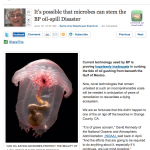 “Pet” Giant Pycnogonid attacking computer.
“Pet” Giant Pycnogonid attacking computer.
This morning my email was flooded with friends, family, and colleagues notifying me of this story. What’s not to love about a story that combines gigantism, the deep, and Antarctica all in one? An Australian led expedition to the deep Southern Ocean aboard the Aurora Australis, in conjunction with France’s L’Astrolabe and Japan’s Umitaka Maru, is making news today. The highlights include giant deep-sea creatures, wonderful video footage, and evidence of of scarring of the seafloor by icebergs. On a side note, I’ve been aboard the Umitaka Maru, or “The Flying Eagle”, and its amazingly fast vessel with a wonderful crew. The goal of the mission, under of the Census of Marine Life, is to explore and characterize biodiversity.
The two most well-known body size phenomena to occur in marine habitats is abyssal gigantism and polar gigantism. It is unclear if the same reasons that some organisms obtain huge sizes in the deep also explains why things are bigger at the poles. Frustratingly, the media coverage seems to be confusing these concepts. The classic example of both polar and abyssal gigantism is the giant pycnogonid sea spiders. Off the California coast giant pycnogonids are fairly common, as with most of the deep sea, and large specimens are frequently encountered around whale falls. In the Antarctic shallow water (coastal) pycnogonids also reach incredible sizes rare among shallow species of this group. So is the finding of giant polar sea spiders abyssal giantism or polar gigantism and is it novel? I would advocate that this is more of a case of abyssal gigantism as the samples are from greater than 200m although the media seems to be equating this with polar gigantism. The finding is also not particularly new. In the 1880’s, Mosely noted in his Nature article the occurrence of giant sea spiders in trawls from the deep. You can read my old post here, here, and here about body size in the deep.
Also interesting, and also noticed by Kevin, is an error occurs in the video. The announcer discusses giant sea spiders, while what is shown is a swimming crinoid. Pycnogonids are a group of arthropods related to horseshoe crabs while crinoids are well…echinoderms! CNN also gets this wrong with the caption of this video. All of this shouldn’t distract from the importance of the expedition or from you enjoying the video or looking at the amazing photographs (below the fold).

“Glass-like” tunicates. Photo: Antarctic Division

Ice berg gouges on the sea floor. Photo: Antarctic Division

A mix sponges, corals, and brittle stars. Photo: Antarctic Division






I dunno… Anybody else getting H.P. Lovecraft flashbacks?
What’s not to love about shoggoths?
I love those bubble creatures. They look like they came from Bikini Bottom. On another note, those chains in the video bother me. They seem very close to the creatures, or is that an illusion of perspective?
Video not working, says it is “Private” and I need to be your friend to see it. I would happily be your friend, but now I sound like Barney. Shudder.
Thanks for the heads up Judith. It is not working on CNN’s website either so they must have decided not to share :(